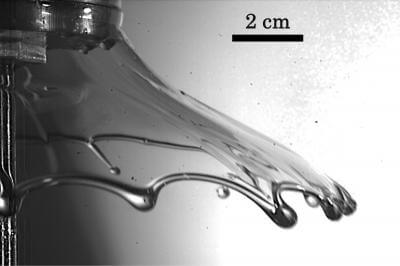Sunny Jung continues to redefine the views on the laws of physics, and in doing so, impacts the research on topics as varied as drug delivery methods to fuel efficiency.
In a paper appearing this month in Physical Review E, Young and five colleagues reported on the dynamics of squeezing fluids using a simple experiment of clapping with wet hands. As an engineer, Jung described “this outburst of fluid motion” as the unusual physical phenomena.
Earlier in his career, Jung, an assistant professor of engineering science and mechanics at Virginia Tech, made headlines in the New York Times for his study with peers from MIT and Princeton on how a cat exploits fluid inertia to defeat gravity and actually pulls liquid into the feline’s mouth. The implications of this research can be used in understanding more about the technology of microfluidics, the behavior of fluids at the microscale level, including pharmaceutical drug deliveries into the fluids in the human body.
In a different study involving liquids, Jung showed how certain identical flows of fluids, normally thought to coalesce to form a single mass of fluid, would not if the speed of the flow was increased beyond a certain threshold. Understanding this reaction of fluid flows has implications for the mixing of fuel fluids in order to maximize combustion to attain fuel efficiency.
Jung’s achievements in fluid flow won him the 2010 international Milton Van Dyke award from the American Physical Society. He had only received his doctorate in physics five years earlier from the University of Texas at Austin.
Now, Jung’s most recent paper on fluid flow speaks to the reaction of thin films of liquid when compressed vertically between two objects. The film is ejected radically and generates fluid treads and droplets at a high speed.
A simple example of this physics phenomenon is part of the title of his paper: Dynamics of squeezing fluids: Clapping wet hands.
“Everyone has experienced water drops hitting one’s face when wet hands are clapped,” Jung said. The scientific question is why does a thin film of liquid, in this case, water on the hands, break into small drops by the squeezing or clapping motion.
“To transit from a film to drops, fluids need to undergo instability, and in this case, it is the up and down crown splash due to surface tension,” Jung explained.
“Another example might be water splash when you step into a thin water puddle. This example is a little bit different from the current study in terms of plate geometry, but the underlying physics is shared,” Jung added.
Other comparable fluids such as gasoline and oil behave similarly but a very viscous fluid such as honey would not.
Oil companies are interested in this research because of the oil separation process. In this process, “such interfacial dynamics of multiphase fluids serve as one of the fundamental mechanisms,” Jung explained.
If our reporting has informed or inspired you, please consider making a donation. Every contribution, no matter the size, empowers us to continue delivering accurate, engaging, and trustworthy science and medical news. Independent journalism requires time, effort, and resources—your support ensures we can keep uncovering the stories that matter most to you.
Join us in making knowledge accessible and impactful. Thank you for standing with us!

